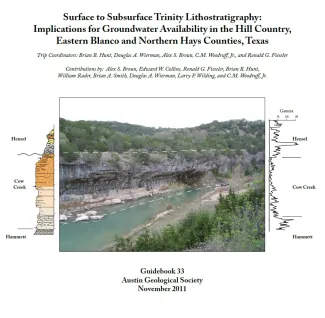
Publication Details
Get the Publication
$17.50
Abstract/Description:
This field trip is a follow-up and complement to the publication of the Hydrogeologic Atlas of the Hill Country Trinity Aquifer, Blanco, Hays, and Travis Counties, Central Texas (referenced as Wierman et al., 2010 or “HA” throughout this guidebook). For reference, the HA is included as an Appendix at the end of this guidebook. The HA and work presented in this guidebook builds upon the analyses done by many geoscientists—too many to name here, but many are included in the references of the HA.
The purpose of this trip is to take a detailed look at the lithostratigraphy of the Lower Cretaceous, Trinity Group formations in outcrop (Stops 1–4), and how they relate to subsurface data (see Broun, this volume) with the ultimate goal of better understanding the hydrogeology of the Trinity Aquifer (see Wierman, this volume). Understanding the fundamental lithostratigraphy is the first step to unraveling the hydrogeology of the complex aquifer system and its sustainable management. The availability of groundwater for human and ecological needs is paramount to the health and welfare of the Texas Hill Country. Recent studies have shown the finite nature of the groundwater resources and are the primary motivation for the HA and this guidebook. Figure 1 below illustrates the results from numerical modeling regarding water level declines and pumping from the Middle Trinity Aquifer based upon projected pumping into 2060.
This field trip will provide a unique look at the lithostratigraphy of a significant portion of the Trinitian-age units. Figure 2 is a regional geologic map showing the locations of stops, and Figure 3 illustrates the lithostratigraphic units that will be visited and discussed in this guidebook. Stops 1–4 provide a detailed look at the lithostratigraphy of the Trinity units in measured sections, hand- and thin-section samples with an emphasis on lithology and porosity, which greatly influence groundwater availability.
Four papers or supplemental figures are included to provide additional information for both the surface and subsurface Trinity. Alex S. Broun presents stratigraphic cross sections and completion logs (geophysical and cuttings descriptions) that interpret the subsurface lithostratigraphy, which correlate into the field-trip outcrops. Douglas A. Wierman applies the information learned from the lithostratigraphic work and relates it directly to water availability using water-level data. William Rader discusses the faunal “marker” beds found within the Trinity, which help provide stratigraphic control and also illuminate the depositional setting of the various units. A paper by Woodruff and Wilding discusses the misnomer of the term “marl” as it is applied to the Glen Rose, and the influence of these units on the shallow hydrology.
We hope you find this guidebook and field trip both interesting and useful to future hydrogeologic investigations in this area.